人口老龄化-学术英语演讲PPT
- 格式:ppt
- 大小:10.94 MB
- 文档页数:13
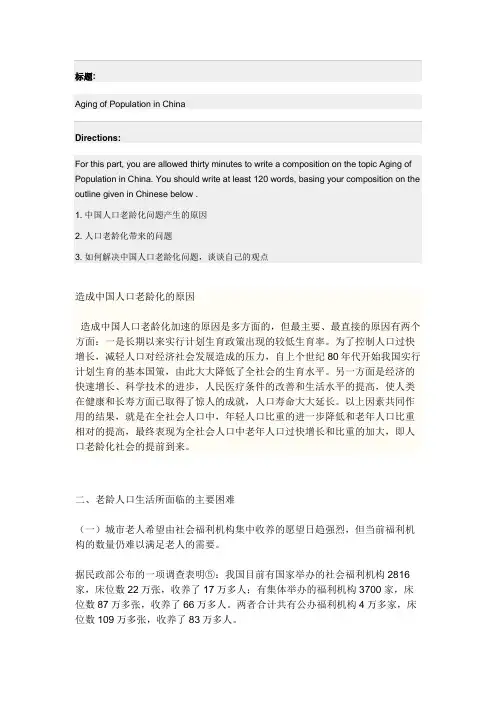
Aging of Population in ChinaFor this part, you are allowed thirty minutes to write a composition on the topic Aging of Population in China. You should write at least 120 words, basing your composition on the outline given in Chinese below .1. 中国人口老龄化问题产生的原因2. 人口老龄化带来的问题3. 如何解决中国人口老龄化问题,谈谈自己的观点造成中国人口老龄化的原因造成中国人口老龄化加速的原因是多方面的,但最主要、最直接的原因有两个方面:一是长期以来实行计划生育政策出现的较低生育率。
为了控制人口过快增长,减轻人口对经济社会发展造成的压力,自上个世纪80年代开始我国实行计划生育的基本国策,由此大大降低了全社会的生育水平。
另一方面是经济的快速增长、科学技术的进步,人民医疗条件的改善和生活水平的提高,使人类在健康和长寿方面已取得了惊人的成就,人口寿命大大延长。
以上因素共同作用的结果,就是在全社会人口中,年轻人口比重的进一步降低和老年人口比重相对的提高,最终表现为全社会人口中老年人口过快增长和比重的加大,即人口老龄化社会的提前到来。
二、老龄人口生活所面临的主要困难(一)城市老人希望由社会福利机构集中收养的愿望日趋强烈,但当前福利机构的数量仍难以满足老人的需要。
据民政部公布的一项调查表明⑤:我国目前有国家举办的社会福利机构2816家,床位数22万张,收养了17万多人;有集体举办的福利机构3700家,床位数87万多张,收养了66万多人。
两者合计共有公办福利机构4万多家,床位数109万多张,收养了83万多人。
这与我国数以亿计的福利服务对象(老年人口1.3亿多,还有数百万的孤残儿童和“三无”残疾人)相比,集中收养的床位数只占0.7%多一点,而集中收养的人数则不足0.6%,与发达国家一般集中收养人数占5-7%的比例相差甚远。
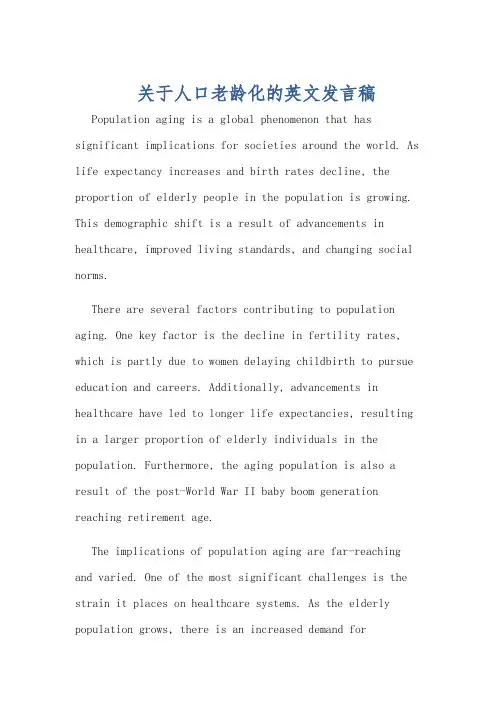
关于人口老龄化的英文发言稿Population aging is a global phenomenon that has significant implications for societies around the world. As life expectancy increases and birth rates decline, the proportion of elderly people in the population is growing. This demographic shift is a result of advancements in healthcare, improved living standards, and changing social norms.There are several factors contributing to population aging. One key factor is the decline in fertility rates, which is partly due to women delaying childbirth to pursue education and careers. Additionally, advancements in healthcare have led to longer life expectancies, resulting in a larger proportion of elderly individuals in the population. Furthermore, the aging population is also a result of the post-World War II baby boom generation reaching retirement age.The implications of population aging are far-reaching and varied. One of the most significant challenges is the strain it places on healthcare systems. As the elderly population grows, there is an increased demand forhealthcare services and long-term care facilities. This can lead to higher healthcare costs and a shortage of healthcare professionals trained to care for elderly patients.Another challenge of population aging is the impact on the labor force. With a larger proportion of the population in retirement, there are fewer working-age individuals to support the economy. This can result in labor shortages, decreased productivity, and increased pressure on social security and pension systems.In addition, population aging can also have social implications. The traditional family structure may be disrupted as more elderly individuals live alone or in care facilities. This can lead to feelings of isolation and loneliness among the elderly population. Furthermore, there may be a shift in cultural norms and values as the proportion of elderly individuals in society increases.To address the challenges of population aging, governments and policymakers must implement strategies to support the growing elderly population. This may include investing in healthcare infrastructure, promoting healthyaging initiatives, and developing policies to support caregivers. Additionally, there is a need to encourageolder adults to remain active and engaged in their communities to combat feelings of isolation and loneliness.Overall, population aging is a complex and multifaceted issue that requires a coordinated and comprehensive response. By understanding the factors contributing to population aging and its implications, societies can better prepare for the challenges and opportunities that come with an aging population.人口老龄化是一个全球性现象,对世界各国的社会产生重要影响。
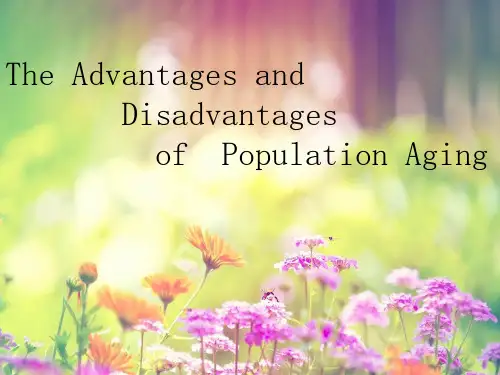
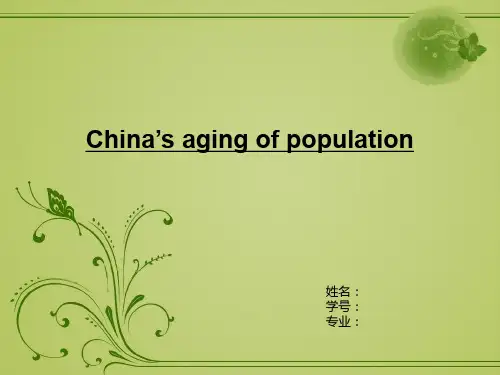


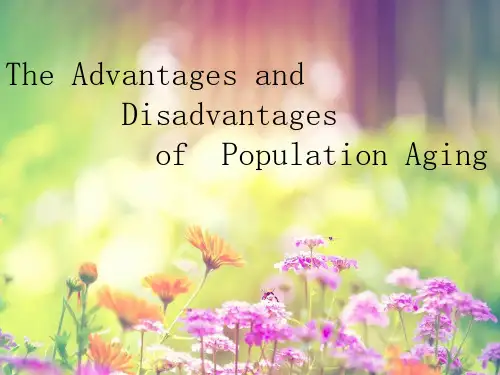


Aging of Population in ChinaFor this part, you are allowed thirty minutes to write a composition on the topic Aging of Population in China. You should write at least 120 words, basing your composition on the outline given in Chinese below .1. 中国人口老龄化问题产生的原因2. 人口老龄化带来的问题3. 如何解决中国人口老龄化问题,谈谈自己的观点造成中国人口老龄化的原因造成中国人口老龄化加速的原因是多方面的,但最主要、最直接的原因有两个方面:一是长期以来实行计划生育政策出现的较低生育率。
为了控制人口过快增长,减轻人口对经济社会发展造成的压力,自上个世纪80年代开始我国实行计划生育的基本国策,由此大大降低了全社会的生育水平。
另一方面是经济的快速增长、科学技术的进步,人民医疗条件的改善和生活水平的提高,使人类在健康和长寿方面已取得了惊人的成就,人口寿命大大延长。
以上因素共同作用的结果,就是在全社会人口中,年轻人口比重的进一步降低和老年人口比重相对的提高,最终表现为全社会人口中老年人口过快增长和比重的加大,即人口老龄化社会的提前到来。
二、老龄人口生活所面临的主要困难(一)城市老人希望由社会福利机构集中收养的愿望日趋强烈,但当前福利机构的数量仍难以满足老人的需要。
据民政部公布的一项调查表明⑤:我国目前有国家举办的社会福利机构2816家,床位数22万张,收养了17万多人;有集体举办的福利机构3700家,床位数87万多张,收养了66万多人。
两者合计共有公办福利机构4万多家,床位数109万多张,收养了83万多人。
这与我国数以亿计的福利服务对象(老年人口1.3亿多,还有数百万的孤残儿童和“三无”残疾人)相比,集中收养的床位数只占0.7%多一点,而集中收养的人数则不足0.6%,与发达国家一般集中收养人数占5-7%的比例相差甚远。
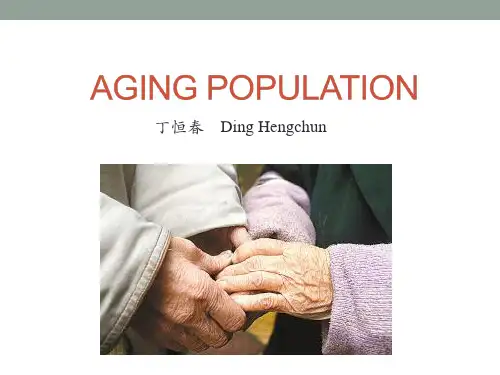
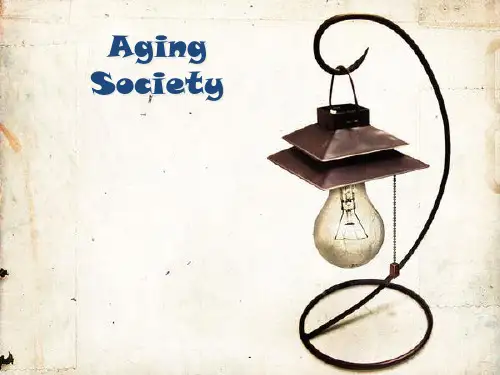
关于人口老龄化的英文发言稿Population Aging: A Global Challenge and OpportunityThe world is undergoing a profound demographic shift, one that will have far-reaching implications for societies, economies, and individuals. Population aging, a phenomenon characterized by an increasing proportion of older adults in the population, is a global phenomenon that is transforming the social and economic landscape of nations.At the heart of this demographic transformation is the remarkable success of public health initiatives, medical advancements, and improved living standards, which have led to increased life expectancy and declining fertility rates. As a result, the proportion of older adults, defined as those aged 65 and above, is steadily rising, and in many countries, it is projected to continue to grow in the coming decades.The implications of population aging are multifaceted and complex. On the one hand, it represents a remarkable achievement in human development, as people are living longer and healthier lives. However, it also presents significant challenges that requirecomprehensive and coordinated responses from policymakers, healthcare providers, and communities.One of the primary concerns associated with population aging is the strain it places on social security and healthcare systems. As the proportion of older adults increases, the demand for pensions, long-term care, and medical services also rises, often outpacing the available resources and funding. This can lead to increased government spending, higher taxes, and potential shortfalls in the provision of essential services.Furthermore, population aging can have significant implications for the labor force and economic productivity. As the working-age population declines relative to the older population, there may be a shortage of skilled workers, which could hamper economic growth and innovation. This, in turn, can lead to challenges in maintaining a sustainable social safety net and supporting the growing number of retirees.However, population aging also presents opportunities for societies to adapt and thrive. Older adults possess a wealth of knowledge, experience, and wisdom that can be leveraged to drive innovation, mentorship, and community engagement. By embracing the concept of active and healthy aging, governments and communities can empower older adults to remain engaged, productive, andcontributing members of society.One promising approach is the development of age-friendly environments that cater to the needs and preferences of older adults. This includes accessible infrastructure, inclusive public spaces, and tailored services that enable older adults to live independently, participate in social activities, and access healthcare and other essential resources.Additionally, technological advancements can play a crucial role in supporting population aging. Innovations in assistive technologies, telemedicine, and smart home solutions can enhance the quality of life for older adults, allowing them to maintain their independence and receive personalized care and support.Addressing the challenges and harnessing the opportunities presented by population aging will require a multifaceted and collaborative approach. Policymakers must work closely with healthcare providers, employers, and community organizations to develop comprehensive strategies that address the diverse needs of older adults, while also fostering an environment that celebrates the contributions and potential of this growing demographic.In conclusion, population aging is a global phenomenon that demands our attention and action. By embracing the opportunities itpresents and addressing the challenges it poses, we can create a future where older adults are empowered, communities are age-friendly, and societies are equipped to navigate this profound demographic transformation. Through collective efforts and innovative solutions, we can ensure that population aging becomes a catalyst for a more inclusive, sustainable, and prosperous world for all.。